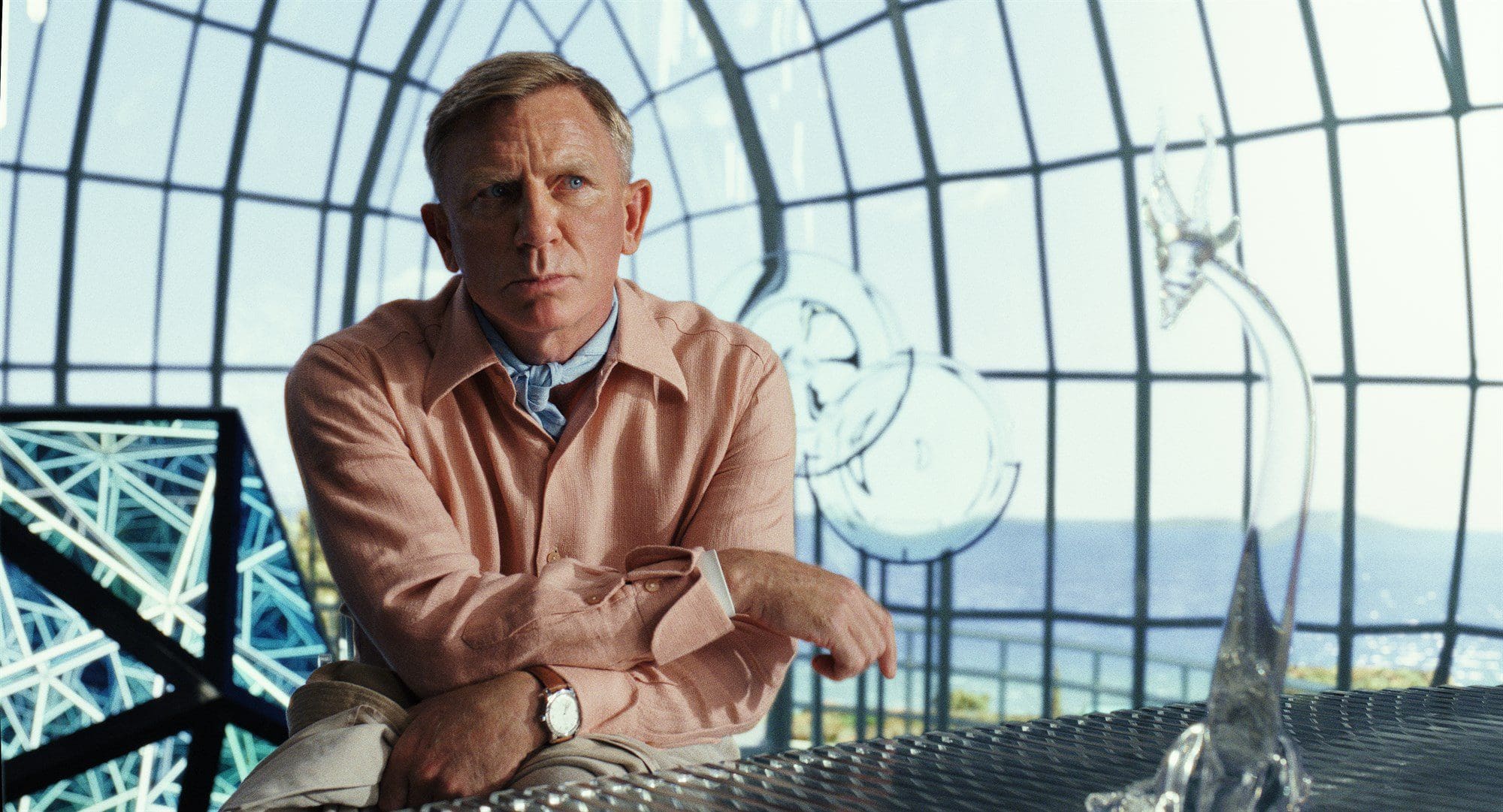
The first Knives Out used seemingly firm foundations that would later be flipped on their head. This is sold to the audience in the first scene, when we see the corpse at the center of the mystery. In Glass Onion, we don’t see a corpse until an hour into the movie, because this sequel’s pleasures come from obfuscation. You might have an idea of who will be the assailant and who will be the assailed, and you probably won’t be too off. However, this first hour throws so much information at you, so many characters, dynamics, and (apparent) nonsense, it’s best to know you should go with the flow.
The new ensemble has Claire (Kathryn Hahn), who is running for Governor, Duke (Dave Bautista), a popular men’s rights streamer who has greater media aspirations, Lionel (Leslie Odom Jr.), a higher-up scientist at Alpha Industries, Birdie (Kate Hudson), a foolishly bigoted fashionista, Birdie’s assistant Peg (Jessica Henwick), and Andi (Janelle Monae), founder and former co-CEO of Alpha Industries. Andi was recently ousted by the other co-ceo, Miles Braun (Edward Norton).
All of these characters and their careers matter, but I can’t say how in this review. What I can say is they’re all invited–along with Benoit Blanc–to Braun’s garish mansion (the titular Glass Onion) on a private island for a murder mystery party. Blanc’s introduction in Knives Out, showing him overseeing simple interrogations, is a testament to Johnson’s familiarity with murder mysteries, but his introduction in Glass Onion re-establishes the audience’s familiarity with Blanc himself. He’s on a zoom call in a bathtub, playing Among Us with celebrity friends (including the late Angela Lansbury and Stephen Sondheim). He’s not taking lockdown well, so he takes this invitation with glee. On first viewing of Knives Out, audiences were led to believe Blanc could be an idiot or antagonist, but now that we know he’s neither, he is Glass Onion’s anchor for the first hour. He’s the person we trust through the nonsense and noise of these distinctly vain, silly, and compelling people.
I’ve seen it said that the first hour feels disjointed and aimless, emphasizing sillier comedy without propelling the narrative. This is a sympathetic criticism, especially if the film’s humor doesn’t work for you, but, beyond merely being impressive that Glass Onion finds so much clarity in so much insanity, the seemingly disorienting ride is fun precisely because of the underlying knowledge that murder awaits.
There’s a scene in Miles’s living room, while characters party in the same room as the Mona Lisa (the real thing). As a security precaution, anytime someone gets close to the painting, a protective barrier rises. In this scene, nearly every character is present, and nearly every subplot referred to, and it won’t be until a second viewing that you’ll understand the drama that’s escalating under the surface. Magnificently edited by Bob Duscay, it’s all disguised as irrelevant, casual conversation, but the film disruptively cuts to close-ups of the Mona Lisa as the barrier loudly rises and slams, each slam getting louder, each shot getting closer to her eyes. However casual the conversation seems, these disruptive close-ups provide an unsettling sense of propulsion amidst the noise.
In his commentary for Knives Out, Johnson spoke about murder mysteries being intrinsically cinematic because of the genre’s reliance on re-contextualizing events and images, and he takes this to another level with cinematographer Steve Yedlin. Their delightful and dense images will satisfy before and after they’re re-contextualized. Take a scene when the characters are poolside. We have a profile shot of Birdie that pushes in on her until all we see in the frame are Birdie and her absurd hat. She reminisces about the past, until she removes her hat and we see Andi sitting in the background. With Andi’s revelation, the scene takes a dramatic turn. Later, we see this scene from a different angle, this time showing Andi’s presence from the start, with her, Birdie, and Peg all taking up relatively equal importance in the frame. When Birdie takes off her hat in this flashback, it takes up significantly less of the frame, and yet, the audience knows to look for it, because we know it signifies the dramatic shift.
Basically, we’re not supposed to look for the clues until we’re told to, and this is an apt way to understand how to view the film. Personally, it’s why I love watching murder mysteries, even if they end up sucking (which Glass Onion doesn’t): I enjoy the ride of the mystery. It could have the dumbest, least satisfying resolution, and I’m still glad I sat through the mystery of it.
As such, I don’t like to look for the clues until I’m told to.
Rian Johnson seems to understand this, and seems to love taking his audience on a disorienting ride that still has an obvious conclusion. Blanc specifically comments on this in understanding the Glass Onion itself, as a metaphor. The inverse of Knives Out’s donut comparison, Blanc talks about how the Glass Onion seems to have all these complex, deep layers that could be peeled at forever…when really, the answer is crystal clear.
But while the answer will eventually seem crystal clear, the pleasures of that obviousness go hand in hand with the initial obfuscation. So remember: when watching Glass Onion, don’t look until you’re told to.

